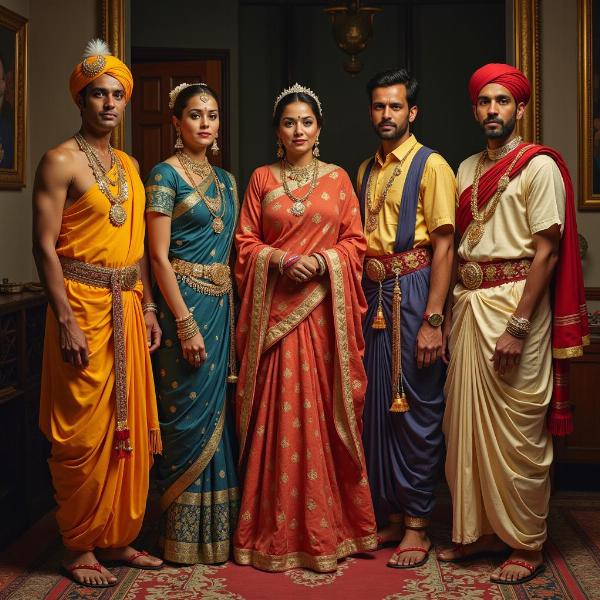Blue blood meaning in Hindi often evokes images of royalty and aristocracy. But what does this intriguing phrase truly signify in the Indian context? This article delves into the meaning, origin, and cultural significance of “blue blood” in Hindi, exploring its fascinating connection to nobility and social status.
The Aristocratic Origins of “Blue Blood”
The phrase “blue blood” doesn’t actually refer to the color of one’s blood! Its roots lie in the Spanish term “sangre azul,” which described the fair-skinned nobility of Castile. Their pale complexion, unlike the tanned skin of the working class, allowed their blue veins to be easily visible, leading to the association of blue veins with high social standing. This concept later spread throughout Europe and eventually found its way into other languages, including Hindi.
नीली रक्त (Nili Rakt): The Hindi Equivalent
In Hindi, “blue blood” is often translated as नीली रक्त (nili rakt). While the literal translation holds, its usage is nuanced. It doesn’t merely signify a literal blue hue of blood but rather connotes a lineage of nobility, inherited status, and aristocratic ancestry. It’s used to describe individuals or families who are considered part of the elite or upper class, often due to their lineage or inherited wealth.
Beyond Literal Translation: Cultural Connotations
The concept of “blue blood” resonates deeply within Indian society, where lineage and family history hold significant cultural weight. The caste system, although officially outlawed, continues to influence social dynamics in many parts of the country. “Blue blood,” in this context, can sometimes allude to individuals belonging to traditionally higher castes, though its usage is evolving to encompass those who have achieved significant wealth or influence, regardless of their ancestral background.
 Indian Royal Family Portrait
Indian Royal Family Portrait
“Blue Blood” in Modern India: A Shifting Landscape
While the historical roots of “blue blood” are firmly planted in aristocracy, its meaning in modern India is becoming more fluid. The rise of a new class of wealthy entrepreneurs and influential figures has challenged traditional notions of elite status. Today, “blue blood” can also describe individuals who have achieved significant success and prominence through their own efforts, regardless of their family background. This reflects a broader societal shift towards valuing merit and achievement alongside inherited privilege.
Is it Just About Wealth? Exploring Other Dimensions
While wealth often accompanies “blue blood” status, it’s not the sole defining factor. The phrase also encapsulates a certain level of cultural refinement, education, and social influence. “Blue-blooded” individuals are often perceived as having impeccable manners, a sophisticated lifestyle, and access to exclusive social circles. This broader interpretation acknowledges that social status is a complex interplay of various factors, including wealth, ancestry, education, and influence.
Do You Have Blue Blood? A Question of Relevance
In today’s world, the concept of “blue blood” is increasingly being questioned. As societies become more egalitarian, the emphasis on inherited privilege is diminishing. While the phrase still holds cultural weight, its relevance is gradually declining, particularly among younger generations who prioritize merit and hard work over ancestral lineage.
Conclusion: “Blue Blood” – A Legacy in Transition
“Blue blood meaning in Hindi” represents a complex interplay of history, culture, and social dynamics. While its origins lie in aristocratic lineage, its meaning is evolving to encompass a broader spectrum of social status in modern India. Whether it signifies inherited privilege or achieved success, the phrase continues to evoke a sense of exclusivity and elite standing.
FAQ:
- What is the literal meaning of “blue blood” in Hindi? The literal translation is नीली रक्त (nili rakt).
- Does “blue blood” always refer to royalty in India? Not necessarily. It can also refer to families of high social standing or those who have achieved significant wealth and influence.
- Is the concept of “blue blood” still relevant in modern India? Its relevance is declining, particularly among younger generations, but it still holds cultural weight.
- What are some other ways to describe someone of high social standing in Hindi? Terms like कुलीन (kuleen – noble) or उच्च वर्ग (uchch varg – upper class) can be used.
- Does “blue blood” have negative connotations in India? It can sometimes be perceived as elitist or exclusionary.
Meaning-Hindi.in is your premier destination for high-quality Hindi translation services. We specialize in various domains, including business, legal, technical, website localization, educational, and specialized translation. Whether you need fast turnaround times or expert handling of specific terminology, our team of experienced linguists delivers accurate and culturally sensitive translations. Contact us today for all your Hindi translation needs at [email protected] or +91 11-4502-7584. Meaning-Hindi.in is here to bridge the language gap and connect you to the world.